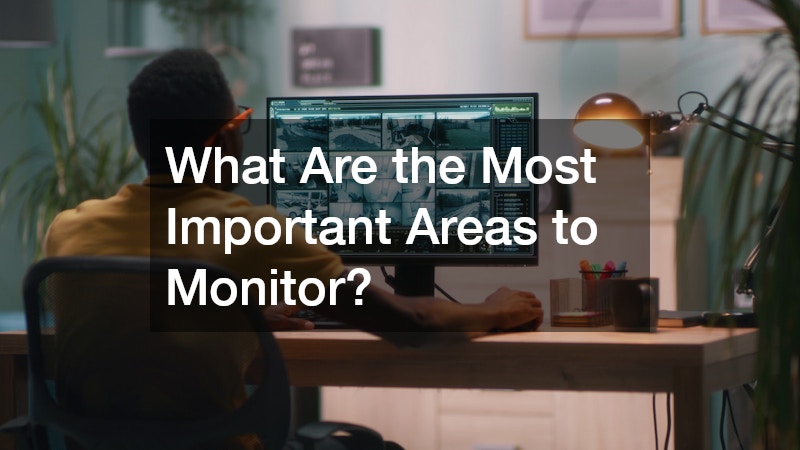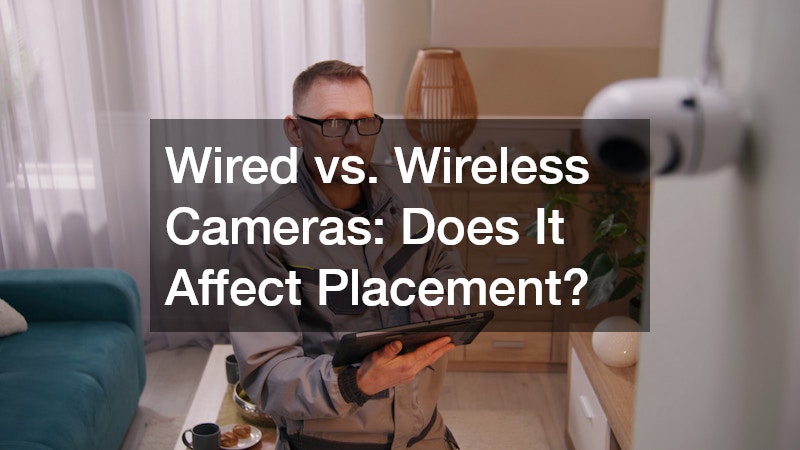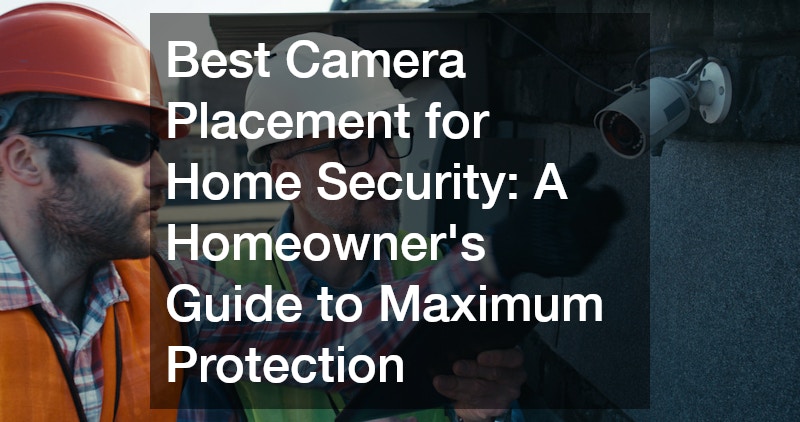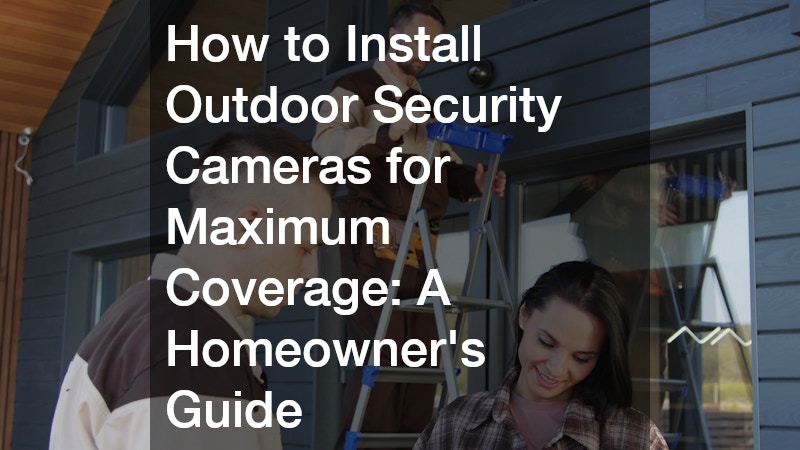
When it comes to safeguarding your home, security cameras are a powerful deterrent and investigative tool. But installing cameras isn’t just about buying the latest gadget and sticking it on the wall—strategic placement is key. Improperly placed cameras can leave dangerous blind spots, while well-positioned ones can offer full visibility and peace of mind.
For homeowners, understanding where to install security cameras can mean the difference between catching suspicious activity and missing it altogether. From front door monitoring to backyard surveillance and indoor camera logic, every zone requires a different approach.
This guide offers clear, expert-backed advice to help you make the most of your home security system by answering one important question: Where should you place your home security cameras for the best protection?
Why Camera Placement Matters in Home Security
Before diving into specific spots, it’s important to understand why camera placement is so crucial. Simply having cameras isn’t enough—they need to capture what truly matters.
Here’s what proper placement ensures:
- Maximum visibility: Reduce blind spots that intruders may exploit.
- Faster incident response: Better footage means faster identification.
- Crime deterrence: Visible cameras can discourage break-ins.
- Legal clarity: Footage with clear views helps with police reports or insurance claims.
Bad placement, on the other hand, can compromise your home security and render expensive equipment useless.
What Are the Most Important Areas to Monitor?

Every home is unique, but there are common areas where security camera coverage is essential. Here’s a breakdown of key locations.
1. Front Door
An estimated 34% of burglars enter through the front door. This makes it the top priority.
Best Practices:
- Position the camera above the door, angled downward.
- Use a weather-resistant camera with night vision.
- Avoid pointing it directly at light sources to reduce glare.
- Consider a video doorbell for close-up facial recognition.
2. Back and Side Doors
Secondary entrances are often less visible but equally vulnerable.
Tips:
- Install at the top corner of the doorframe.
- Cover any dark corners or staircases near these doors.
- Use motion-triggered floodlights to enhance footage at night.
3. Windows Not Facing the Street
Windows on the side or back of the house are common break-in points.
Recommendations:
- Mount cameras facing these windows from the outside or across the room inside.
- Use wide-angle lenses to capture more area.
4. Garage and Driveway
Garages house valuables like vehicles, tools, and often lead directly into the home.
Where to install:
- Outside the garage door, to monitor the approach and license plates.
- Inside the garage to monitor any break-ins or unauthorized access.
- Above the driveway entrance for added car and guest tracking.
5. Yard and Backyard
Backyards offer intruders a hidden entry path.
For these areas:
- Mount cameras on elevated corners of the house.
- Ensure cameras are out of reach to prevent tampering.
- Look for models with infrared night vision or motion-activated lights.
Indoors: Should You Place Cameras Inside Your Home?
Many homeowners debate whether or not to place cameras indoors. The answer depends on your security priorities.
When to place cameras indoors:
- To monitor babysitters, cleaning services, or elderly care.
- To keep an eye on pets or children when you’re away.
- To catch intruders who make it past exterior cameras.
Smart indoor placement tips:
- Angle cameras toward entry points and main hallways.
- Avoid placing cameras in private areas like bathrooms or bedrooms to respect privacy.
- Choose cameras with cloud storage and real-time alerts.
Best Camera Placement for Home Security: Avoid These Common Mistakes
Even the best cameras can underperform when placed incorrectly. Let’s go over some common mistakes homeowners make with security camera placement.
Mistakes to avoid:
- Placing cameras too high: A wide aerial view may look cool, but it often fails to capture facial details.
- Facing cameras into direct sunlight: This can lead to overexposed and unusable footage.
- Ignoring corners: Many homeowners overlook side entrances and corners, leading to blind spots.
- Using indoor cameras outdoors: These are not weather-sealed and may break quickly.
- Not testing camera angles before final installation.
Pro tip: Use your smartphone to simulate camera angles before drilling holes or mounting devices.
How Many Cameras Do You Really Need?
The number of cameras needed depends on the size and layout of your home. A small house might only need 4–5 cameras, while a larger property could require 8–12 or more.
Here’s a rough guideline:
| Home Area | Number of Cameras |
| Front Door | 1 |
| Back/Side Doors | 2–3 |
| Garage & Driveway | 1–2 |
| Interior Entryways | 1–2 |
| Backyard or Perimeter | 2–3 |
| Total (average home) | 6–10 |
Don’t forget to factor in smart home integration and Wi-Fi signal strength—especially for outdoor installations.
What Camera Features Enhance Placement Strategy?
Camera placement works best when paired with the right features. Here’s what to look for:
Must-have features for strategic placement:
- Wide-angle lens: Covers more area with fewer cameras.
- Night vision: Essential for outdoor and low-light conditions.
- Motion detection: Saves power and bandwidth by only recording when needed.
- Cloud or local storage: Choose based on your security preferences.
- Mobile alerts: Get notified of movement in real time.
- Two-way audio: Useful at entry points or front porches.
- Tamper-resistant design: Avoid vandalism or sabotage.
Pairing the right features with the right placement maximizes your system’s effectiveness.
Wired vs. Wireless Cameras: Does It Affect Placement?

Absolutely. Whether you choose wired or wireless cameras will impact both where and how you install them.
Wired Cameras
- Pros: Stable connection, continuous power.
- Cons: Harder to install, less flexible for placement.
- Best placement: Permanent positions like front doors or inside garages.
Wireless Cameras
- Pros: Easy to install, flexible, portable.
- Cons: Dependent on Wi-Fi, requires battery charging or solar power.
- Best placement: Temporary or hard-to-reach areas like trees, fences, or inside rooms.
Tip: Use a mix of both for robust coverage—wired for critical points, wireless for flexible monitoring.
How to Secure Your Security Cameras
Once your cameras are in place, you’ll want to ensure they themselves aren’t vulnerable.
Security tips:
- Use password-protected networks to prevent hacking.
- Keep camera firmware updated.
- Install cameras out of reach, or in vandal-proof housings.
- Use encryption if available, especially for cloud-based systems.
How Can Lighting Impact Camera Performance?
Lighting plays a critical role in the effectiveness of your home security cameras. Poor lighting can result in blurry, overexposed, or pitch-black footage—none of which helps identify intruders. To get the clearest images, avoid placing cameras directly opposite light sources like porch lights or bright windows, as this causes glare or silhouettes. Instead, opt for angled placement that takes advantage of natural lighting during the day and infrared or LED illumination at night.
You can also install motion-activated floodlights in key areas like the driveway, backyard, and side entrances. These not only improve video clarity but also startle potential intruders, acting as an added deterrent. Some smart cameras come with built-in spotlights, combining lighting and surveillance in one device. Ultimately, pairing smart camera placement with proper lighting ensures that your footage is useful when it matters most.
Should You Notify Guests About Indoor Cameras?
While you have the right to install security cameras in your home, ethics and laws around privacy are essential to consider, especially for indoor surveillance. If you have guests, housekeepers, babysitters, or maintenance professionals entering your home, it’s a good practice—and in many cases legally required—to inform them about the presence of cameras, particularly indoors.
Placing cameras in common areas like hallways, kitchens, or living rooms is typically acceptable, but never install cameras in private spaces such as bathrooms or guest bedrooms. In some jurisdictions, recording without consent, especially audio, is illegal. Transparency builds trust, avoids legal trouble, and helps foster a safer environment for everyone.
Consider placing small signs at your entrance or including a disclosure in your rental or visitor policy if applicable. If privacy is a concern for occasional visitors, opt for motion-based alerts without continuous recording or use temporary camera disabling options provided by many smart home systems.
Can Dummy Cameras Help Deter Crime?
Dummy cameras—non-functional replicas of real security cameras—are a budget-friendly way to deter crime, especially when used strategically. While they don’t record or transmit video, their realistic design can make potential intruders think twice before targeting your property. When placed in visible, high-traffic areas like the front porch or garage, dummy cameras can contribute to a layered security approach.
However, they shouldn’t replace real cameras altogether. Experienced criminals may be able to spot a fake (especially if there’s no wiring or blinking LED), and in the event of an incident, a dummy offers no real protection or evidence. For maximum impact, pair a dummy camera with real, functional units in hidden or secondary locations.
Use dummy cameras to give the impression of 360° coverage, but always ensure that key entry points are being monitored with genuine equipment. This approach balances cost-efficiency with effective deterrence, especially useful for larger properties or budget-conscious homeowners.
What About Camera Placement for Apartments and Condos?
Security isn’t just a concern for homeowners in single-family houses—apartment dwellers and condo owners also need reliable surveillance. However, shared walls, limited space, and building regulations can make camera placement more challenging. The good news is, there are still smart and legal ways to enhance your security.
For apartment dwellers, focus on the entry door and hallway outside your unit. A peephole camera or video doorbell can be a discreet and effective solution. Just ensure that your placement doesn’t infringe on neighbors’ privacy or violate lease agreements. For condo owners, balconies, garage storage units, and windows facing common areas may benefit from camera coverage.
Always check with your HOA or landlord before installing external cameras. Many buildings have guidelines regarding drilling, wiring, or camera visibility. When installation is limited, consider indoor cameras with motion detection and mobile alerts to monitor movement near doors and windows. Portable, battery-powered units are a great solution for renters and can move with you if you relocate.
Final Thoughts: Building a Security Strategy That Works
The best home security system isn’t just about high-tech equipment—it’s about placing that equipment where it will be most effective. When cameras are properly positioned, you gain more than just footage. You gain peace of mind, safety, and the ability to act quickly in the event of a break-in or emergency.
Don’t rush the installation. Walk around your home. Think like an intruder. Use your phone to test angles and lighting. And if in doubt, consult a professional security installer.
Homeowners who take the time to plan smart camera placements don’t just protect property—they protect peace of mind.



